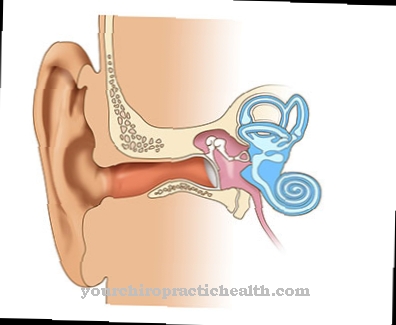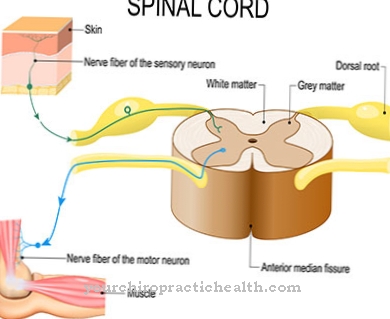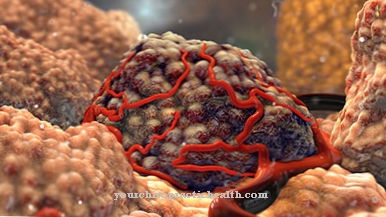The Wiskott-Aldrich Syndrome is an inherited genetic defect that so far can only be cured by a bone marrow transplant. With an incidence of around 1: 250,000, the disease is rare, although only boys are affected due to the X-linked recessive inheritance.
What is Wiskott-Aldrich Syndrome?
As Wiskott-Aldrich Syndrome is a rare genetic immune defect that is inherited in an X-linked recessive manner.
The hereditary disease is characterized by a triad of symptoms consisting of recurrent severe infections as a result of a disturbed immune system, increased bleeding tendency in thrombocytopenia (decreased and functionally restricted number of blood platelets) and eczema, although the individual clinical picture can vary greatly from person to person affected.
As a rule, a Wiskott-Aldrich syndrome manifests itself directly after birth or in the newborn age on the basis of punctiform skin hemorrhages (petechiae). In the further course bloody diarrhea and pronounced injury-related hemorrhage up to internal bleeding and cerebral haemorrhage as a result of the coagulation disorder can occur. In many cases, secondary autoimmune diseases can be observed in Wiskott-Aldrich syndrome. There is also an increased risk of malignant lymphoma.
causes
The Wiskott-Aldrich Syndrome is due to a defect in a certain gene on the shorter arm of the X chromosome that codes for the defective protein (also known as WASP) responsible for the syndrome. The affected gene is important for the correct functioning of the cytoskeleton, which plays an essential role in the synthesis of platelets from the megakaryocytes (precursor cells) and regulates communication and signal transmission between the immune cells.
On the one hand, the mutations cause a reduced number of thrombocytes, which moreover only have a limited functionality, which leads to an increased tendency to bleeding with impaired blood coagulation at the same time. On the other hand, the gene changes cause different defects on different immune cells, which lead to a disturbed signal exchange, a restricted function of the T cells and / or impaired production of antibodies.
As a result of the disturbed immune system, viral, bacterial and mycotic infections manifest themselves repeatedly, which in Wiskott-Aldrich syndrome can be comparatively severe.
Symptoms, ailments & signs
The Wiskott-Aldrich symptom is an immunodeficiency. It is characterized by skin rashes, low platelet counts, and recurrent infections. Symptoms are caused by a malfunction in white blood cells and platelets. This leads to a dysfunctional immune system.
The rashes are often mistaken for neurodermatitis. The reason for this is the similarity to the atopic eczema. In contrast to neurodermatitis, eczema can occur in the first weeks of life with the Wiskott - Aldrich symptom. In some cases it becomes severe and the eczema can be accompanied by small bleeding from the skin (hemorrhagic eczema). With the Wiskott-Aldrich symptom it happens that the treated and healed eczema reappears.
The low number of blood platelets can lead to autoimmune diseases. These are characterized by the breakdown of red blood cells (autoimmune hemolytic anemia), the inflammation of small blood vessels in the skin or organs (vasculitis), the breakdown of blood platelets (immune thrombocytopenia) or nephritis or colitis, i.e. inflammation of the kidneys or the large intestine .
Inflammation of the large intestine can manifest itself as bloody or painful diarrhea. Finally, it can lead to an increased susceptibility to infections. These diseases can be otitis media, sinus infections or the like.
Diagnosis & course
A Wiskott-Aldrich Syndrome can usually be diagnosed on the basis of clinical symptoms (particularly petechiae, eczema, recurrent infections).
The diagnosis is confirmed by further blood tests, in the course of which a reduced number and reduced size of the platelets can be determined. The antigen body level is also conspicuous (increased IgE, IgD and IgA concentrations with a reduced IgM value). In the elderly, there is often a disturbed function of the T lymphocytes.
In addition, the specific genetic defect on the WAS gene and thus the expected manifestation of the Wiskott-Aldrich syndrome can be determined as part of the prenatal diagnosis. If the bone marrow transplant is successful, the Wiskott-Aldrich syndrome has a good prognosis and a high chance of recovery. Without a transplant, however, life expectancy is around 10 to 20 years. There is also an increased risk of cancer.
Complications
First and foremost, the Wiskott-Aldrich syndrome leads to very heavy bleeding under the skin. These can have a negative effect on the aesthetics of the person affected, so that many patients feel ashamed of the symptoms and feel uncomfortable with them. The syndrome can also lead to decreased self-esteem or inferiority complexes.
Bleeding can also occur in the internal organs. The blood is then often passed out with bowel movements or urination, causing people to have bloody stools or urine. Sometimes patients suffer a panic attack. Furthermore, anemia sets in, which has a negative effect on the health of the person concerned.
There is permanent tiredness and exhaustion. Likewise, the susceptibility to infections increases and the immune system of the person affected is considerably weakened by the Wiskott-Aldrich syndrome. The treatment of Wiskott-Aldrich syndrome is usually based on the individual symptoms.
These can be limited with the help of medication, without complications. Skin complaints can be limited with the help of creams or ointments. As a rule, the patient's life expectancy is not negatively influenced by the disease.
When should you go to the doctor?
Immediately after the birth, the obstetrician team present checks the health of both the mother and the newborn. Irregularities and abnormalities are documented and, if necessary, further medical tests are arranged. Under optimal conditions, the health characteristics are already noticed and diagnosed in this phase. Parents or relatives therefore do not need to make any further efforts. However, if there are health discrepancies in the further development of the child, a doctor should be consulted.
Bleeding or discoloration of the skin is already cause for concern. If blood is seen in the child's excrement, consult a doctor immediately. If the infant shows behavioral problems, strong restlessness or disturbances in the functioning of the organism, a doctor's visit is necessary. A medical examination is necessary if there are rashes on the skin, abnormal movements or increased body temperature.
In order to establish a diagnosis, the complaints should be discussed with a doctor. Particularities of eating behavior, sleep disorders and irregularities in the reaction should also be clarified by a doctor. Eczema and the development of edema on the body are indications of an existing disease. If persistent or suddenly recurring diarrhea is observed as the child continues to grow and the child complains of pain in the abdomen, it needs medical help.
Treatment & Therapy
The therapeutic measures are aimed at one Wiskott-Aldrich Syndrome on the one hand to eliminate the cause in the context of a causal therapy and on the other hand to treat the symptoms depending on the specific impairments present.
Infectious diseases in those affected by Wiskott-Aldrich syndrome should be treated with antibiotics at an early stage and consistently. If necessary, prophylactic antibiotic therapy is useful. If the synthesis of antibodies is disturbed, subcutaneous or intravenous administration of immunoglobulins is recommended. Thrombocytopenia can be treated with drug therapy with cortisone or high-dose immunoglobulins.
A splenectomy (surgical removal of the spleen) to improve thrombocytopenia can also be considered. In life-threatening conditions as a result of profuse bleeding, transfused platelet concentrates may be indicated. To minimize eczematic skin changes, moisturizing and short-term creams and ointments containing cortisone are used. Dietary measures such as avoiding food containing egg and cow's milk can support the treatment of eczema.
Causally, a Wiskott-Aldrich syndrome can be treated as part of a bone marrow transplant, in which the body's own bone marrow is chemotherapeutically destroyed and then replaced by healthy, infused bone marrow. The best results can be achieved with an early intervention (before the age of five). Gene or gene replacement therapy is another causal treatment method for Wiskott-Aldrich syndrome, which is, however, still being clinically tested.
You can find your medication here
➔ Medicines to strengthen the defense and immune systemprevention
Since that Wiskott-Aldrich Syndrome is a genetic disease, it cannot yet be prevented. Death vaccines are recommended to prevent infections that can be severe, while live vaccines such as those for mumps, measles, rotavirus or chickenpox should be avoided in the presence of Wiskott-Aldrich syndrome.
Aftercare
The Wiskott-Aldrich syndrome is a hereditary disease that cannot yet be treated causally. A causal treatment has only been tested in a few studies, but this option is not an option for most patients due to the risks. As part of the aftercare, the course of the symptoms is checked in order to initiate further measures. Regular check-ups are necessary when administering medication such as co-trimoxazole or penicillin V.
Once any of the symptoms have been resolved, the doctor must regularly review the patient's health after recovery to minimize the risk of severe internal bleeding and other complications. After an infection, the patient must first spend a few days in the hospital. Follow-up care is then necessary.
Follow-up care for Wiskott-Aldrich syndrome is carried out by the responsible internist or another specialist. Multiple follow-up visits are usually indicated after infection. Depending on the severity of the infection, a longer stay in a clinic may be necessary. In addition, therapeutic support for the patient may also be necessary. Psychological help is particularly useful because of the poor prognosis, which is usually associated with Wiskott-Aldrich syndrome.
You can do that yourself
Wiskott-Aldrich syndrome first requires a medical diagnosis and treatment. The therapy of the condition can be supported by various measures at home.
First of all, it is important to observe the sick child closely. If typical symptoms such as painful eczema occur, the doctor must be informed immediately. Infections are usually treated with topical or systemic steroids. The most important self-help measure is to observe the sick person and to inform the doctor in the event of side effects or interactions.
Wiskott-Aldrich syndrome can take various courses, which family members should be carefully informed about. Slightly older children should be informed about their illness. The doctor can provide the most important information materials and contact points. This and a comprehensive medical accompanying therapy enables the patient to live a relatively symptom-free life.
Regular research into new forms of therapy is also important. With regard to the Wiskott-Aldrich syndrome, gene therapies are currently being tested which could prove to be effective in a few years. Patients can participate in testing programs or focus on symptomatic treatment. Which self-help measures make sense is discussed with the responsible specialist.
























.jpg)



